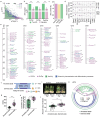A pan-TE map highlights transposable elements underlying domestication and agronomic traits in Asian rice
- PMID: 38962716
- PMCID: PMC11221428
- DOI: 10.1093/nsr/nwae188
A pan-TE map highlights transposable elements underlying domestication and agronomic traits in Asian rice
Abstract
Transposable elements (TEs) are ubiquitous genomic components and hard to study due to being highly repetitive. Here we assembled 232 chromosome-level genomes based on long-read sequencing data. Coupling the 232 genomes with 15 existing assemblies, we developed a pan-TE map comprising both cultivated and wild Asian rice. We detected 177 084 high-quality TE variations and inferred their derived state using outgroups. We found TEs were one source of phenotypic variation during rice domestication and differentiation. We identified 1246 genes whose expression variation was associated with TEs but not single-nucleotide polymorphisms (SNPs), such as OsRbohB, and validated OsRbohB's relative expression activity using a dual-Luciferase (LUC) reporter assays system. Our pan-TE map allowed us to detect multiple novel loci associated with agronomic traits. Collectively, our findings highlight the contributions of TEs to domestication, differentiation and agronomic traits in rice, and there is massive potential for gene cloning and molecular breeding by the high-quality Asian pan-TE map we generated.
Keywords: pan-TE; rice; super pan-genome; transposable element.
© The Author(s) 2024. Published by Oxford University Press on behalf of China Science Publishing & Media Ltd.
Figures




Similar articles
-
Uncovering the breeding contribution of transposable elements from landraces to improved varieties through pan-genome-wide analysis in rice.Front Plant Sci. 2025 Apr 14;16:1573546. doi: 10.3389/fpls.2025.1573546. eCollection 2025. Front Plant Sci. 2025. PMID: 40297728 Free PMC article.
-
Domestication of rice has reduced the occurrence of transposable elements within gene coding regions.BMC Genomics. 2017 Jan 9;18(1):55. doi: 10.1186/s12864-016-3454-z. BMC Genomics. 2017. PMID: 28068923 Free PMC article.
-
Lost genome segments associate with trait diversity during rice domestication.BMC Biol. 2023 Feb 1;21(1):20. doi: 10.1186/s12915-023-01512-6. BMC Biol. 2023. PMID: 36726089 Free PMC article.
-
Taming transposable elements in vertebrates: from epigenetic silencing to domestication.Trends Genet. 2022 Jun;38(6):529-553. doi: 10.1016/j.tig.2022.02.009. Epub 2022 Mar 17. Trends Genet. 2022. PMID: 35307201 Review.
-
The important contribution of transposable elements to phenotypic variation and evolution.Curr Opin Plant Biol. 2022 Feb;65:102140. doi: 10.1016/j.pbi.2021.102140. Epub 2021 Dec 6. Curr Opin Plant Biol. 2022. PMID: 34883307 Review.
Cited by
-
Drought-induced transposon expression reveals complex drought response mechanisms in Brassica napus.Front Plant Sci. 2025 Jul 23;16:1614169. doi: 10.3389/fpls.2025.1614169. eCollection 2025. Front Plant Sci. 2025. PMID: 40772060 Free PMC article.
-
Pangenome analysis of transposable element insertion polymorphisms reveals features underlying cold tolerance in rice.Nat Commun. 2025 Aug 16;16(1):7634. doi: 10.1038/s41467-025-62887-4. Nat Commun. 2025. PMID: 40819063 Free PMC article.
-
Impact of Chromosomal Fusion and Transposable Elements on the Genomic Evolution and Genetic Diversity of Ilex Species.Plants (Basel). 2024 Sep 21;13(18):2649. doi: 10.3390/plants13182649. Plants (Basel). 2024. PMID: 39339625 Free PMC article.
-
Construction of a comprehensive library of repeated sequences for the annotation of Citrus genomes.BMC Genom Data. 2025 Apr 18;26(1):30. doi: 10.1186/s12863-025-01321-6. BMC Genom Data. 2025. PMID: 40247189 Free PMC article.
-
Uncovering the breeding contribution of transposable elements from landraces to improved varieties through pan-genome-wide analysis in rice.Front Plant Sci. 2025 Apr 14;16:1573546. doi: 10.3389/fpls.2025.1573546. eCollection 2025. Front Plant Sci. 2025. PMID: 40297728 Free PMC article.
References
LinkOut - more resources
Full Text Sources
